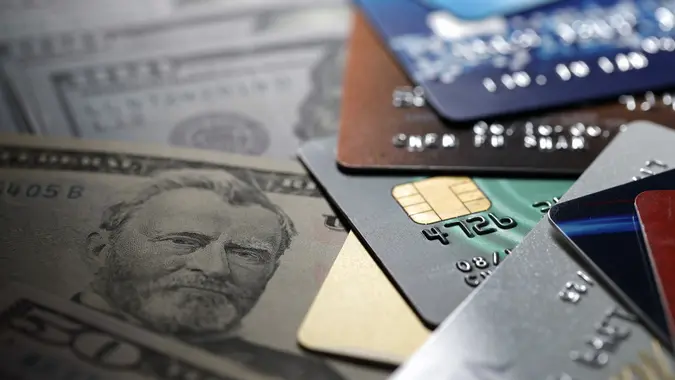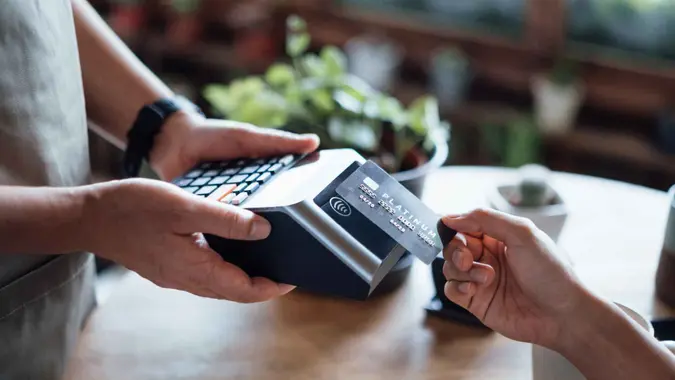What Is a Good APR for a Credit Card?

Commitment to Our Readers
GOBankingRates' editorial team is committed to bringing you unbiased reviews and information. We use data-driven methodologies to evaluate financial products and services - our reviews and ratings are not influenced by advertisers. You can read more about our editorial guidelines and our products and services review methodology.

20 Years
Helping You Live Richer

Reviewed
by Experts

Trusted by
Millions of Readers
Credit cards are convenient, but they can also be costly. If you don’t pay your bill in full every month, you’ll owe interest. The amount you owe is based on the annual percentage rate, or APR, that the card charges. Different types of cards carry different rates. A good credit history can help you get lower rates, but each card usually has a minimum rate regardless of your credit score. Here’s a quick look at how credit card rates are determined, what a low APR is and how low-APR credit cards can help you save money.
Key APR Takeaways
- A good APR for a credit card is relative as it depends on your personal credit, payment history and the type of card you are considering.
- 0% APR is the best you can get, however when this is offered it is temporary, typically part of a promotional period of 12 months.
- A credit card APR below the national average is good, which usually correlates with the credit card interest rates tracked by the Federal Reserve.
- Paying your credit card bill in full every month will negate the impact of the APR as you won’t have to pay interest.
What Does APR Mean?
When you charge purchases to your credit card, you’re technically taking out a loan. Your credit card company pays off your purchase, and you owe the credit card issuer that amount by your due date. If you don’t pay in time, you owe interest. Your APR is typically a yearly rate. So, if your card charges 18% interest and you charge $1,000 to your card and don’t pay it off, you’ll owe an additional $180 by the end of the year.
What Is a Good APR?
The best APR you can hope for is 0%. Though this is attainable, it is usually only temporary as credit card issuers will offer this rate for the first 12 months as part of a promotional period. After that point, credit card rates vary based on the type of credit card. However, if you pay your balance every month you will owe no interest and have built a solid payment history.
Your best bet for finding a truly low APR is to find a dedicated low-rate card. Rewards credit cards, cash-back cards, cards for students and cards for consumers with bad credit tend to have higher interest rates. The current national average for APR ranges between 23% and 24%. If you fall below the average credit card APR, you can consider that good.
Types of Credit Card APRs
Most credit cards offer more than one type of APR. As a consumer, it’s important to understand when each type of rate applies, and how your credit card interest rate might change depending on how and when you’re using your card. Here are five common types of APRs:
- Purchase APR: A purchase APR is a normal rate that applies to a credit card for any purchases you make on the card.
- Introductory APR: Some cards offer a low initial rate, sometimes as low as 0%, to attract business. Typically, this rate only lasts for a limited time, such as six to 18 months. After this time, the rate can jump significantly to the purchase APR you were approved for.
- Balance transfer APR: Some cards offer a reduced rate — as low as 0% for up to 12 to 18 months — if you transfer a balance from one credit card to another. You might pay a transfer fee, which is commonly 3% or more of the amount you transfer.
- Cash advance APR: Unlike cash withdrawals you make with an ATM card, a cash advance is a loan issued to you by your credit card company. You’ll pay a special interest rate on this amount, which is often higher than the standard purchase APR.
- Penalty APR: If you don’t abide by the rules of your credit card account, you’ll be slapped with a penalty APR. This often happens if you are 60 days late or more with your credit card payment. Penalty APRs often top 30%.
Why Is a Low APR Important?
When you open a credit card account, your intention is usually to pay off your entire balance every month before the interest charges hit. If you absolutely have to carry a balance, having the lowest possible interest rate is in your best interest. With an 18% interest rate, your balance will roughly double every four years, thanks to the power of compound interest. With a rate of 4%, however, your balance will take about 18 years to double. The lower your interest rate, the less interest you will pay if you carry a balance on your credit card.
Final Take: How To Lower Your APR
The best way to get a good APR on a credit card is to check your credit before you apply. Most credit scores range from 300 to 850. The higher your score, the more likely a lender will offer you credit at a better rate. You can improve your credit score by making all debt payments on time, having a long credit history, limiting credit applications and keeping your debt low.
FAQ
Here are the answers to some of the most frequently asked questions regarding APRs.- Is an APR of 24% high for a credit card?
- 24% APR is the current national average, though this average has increased substantially over the last few years.
- Is 15% a high APR for a credit card?
- No, though still within the range of the national average, 15% is a decent APR considering the national average is around 23.77%.
- Is an APR of 26.99% good?
- No, 26.99% APR is quite high and above the national average.
John Csiszar contributed to the reporting for this article.
Information is accurate as of Feb 21, 2023.
Our in-house research team and on-site financial experts work together to create content that’s accurate, impartial, and up to date. We fact-check every single statistic, quote and fact using trusted primary resources to make sure the information we provide is correct. You can learn more about GOBankingRates’ processes and standards in our editorial policy.
- Forbes. 2023. "What Is The Average Credit Card Interest Rate This Week? February 13, 2023."
- LendingTree. 2023. "Average Credit Card Interest Rate in America Today."
 Written by
Written by  Edited by
Edited by 
























